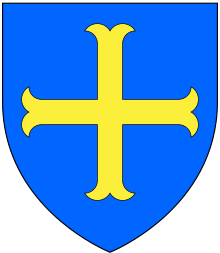|
Molyneux baronets
 There have been three baronetcies created for descendants of the ancient Norman family of Molyneux who were granted extensive estates in Lancashire after the Norman Conquest. The baronetcy of Molyneux of Sefton was created in the Baronetage of England on 22 May 1611 for Richard Molyneux, Member of Parliament for Lancashire on three occasions 1584 to 1611. Successors were raised to the peerage as Viscount Molyneux and Earl of Sefton.[1] The baronetcy of Molyneux of Teversall was created in the baronetage of England on 29 June 1611 for John Molyneux, of a junior branch of the family. Their seat at Teversal, near Mansfield, Nottinghamshire came into the family via the 16th-century marriage of Francis Molyneux to the Teversall heiress, Elizabeth Greenhalgh,[2] and later the Wellow estate, also in Nottinghamshire, devolved upon Sir William Molyneux, 6th Baronet, through his marriage to Anne Challand.[3] This baronetcy became extinct on his only son's death in 1812, the unmarried 7th Baronet, when these Molyneux estates passed to his sister and heir Juliana Molyneux (1749–1808) who married Henry Howard, of Glossop (1713–1787),[4] a descendant of the 22nd Earl of Arundel: their eldest son succeeded as 12th Duke of Norfolk and their second son, Lord Henry Thomas Howard-Molyneux-Howard (1766–1824), had a daughter, Henrietta Anna, who married Henry John George Herbert, 3rd Earl of Carnarvon, whose eldest son, the 4th Earl, was Henry Howard Molyneux Herbert starting a tradition for the Herberts to pass on Molyneux as a middle name. A third baronetcy namely Molyneux of Castle Dillon, County Armagh was created in the Baronetage of Ireland on 4 July 1730 for Thomas Molyneux, a distinguished doctor. His family, who are first recorded in Calais around 1530, settled in Ireland about 1576.  Molyneux of Sefton, Lancashire (1611)
Molyneux of Teversall, Nottinghamshire (1611)
Molyneux of Castle Dillon, County Armagh (1730)
See alsoCitations
Notes
External links |